Video of the Week:
Easy Care Plants
Upcoming Events:

February 4, 2016
Manhattan, KS
Grow Your Garden Center Business in 2016!
We hope you'll join us for this companion conference to the biennial NurseryWorks conference--RetailWorks on Thursday, February 4, 2016 in Manhattan. While NurseryWorks focuses on providing resources for wholesale nursery crop growers, RetailWorks is designed with the independent garden center's needs in mind. We continue to bring in outstanding national and local speakers on a variety of topics. You'll find great content and networking at RetailWorks 2016--get it on your calendar and register today! For more information, go to:
http://retailworks.weebly.com/ or register online at https://2016retailworks.eventbrite.com
Fruit:
Late Blooming and Frost Resistant Peach Trees
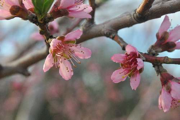
Cultivar Date of full bloom
‘Snow Giant’ April 5
‘Jupiter’ April 7
‘Yukon King’ April 7
‘Burpeach Six’ April 7
‘Fairtime’ April 7
‘Coral Star’ April 7
‘July Sun’ April 7
‘Zee Lady’ April 7
‘May Sun’ April 8
‘Crimson Lady’ April 8
‘Summer Flame’ April 8
‘Elegant Lady’ April 8
‘Sugar Giant’ April 8
‘July Flame’ April 8
‘Sweet Dream’ April 8
‘August Flame’ April 8
‘September Snow’ April 8
‘Snow King’ April 8
‘Star Fire’ April 8
‘Saturn’ April 8
‘August Lady’ April 9
‘Ryan Sun’ April 9
‘Brenda Sun’ April 9
‘All Star’ April 9
‘Autumn Red’ April 9
‘O’Henry’ April 9
‘Opal Moncav’ April 9
‘Rich Lady’ April 9
‘Vista’ April 9
‘Glow Star’ April 9
‘Summer Lady’ April 10
‘Red Star’ April 11
‘Fancy Lady’ April 12
‘Sierra Gem’ April 12
'Intrepid,' though not included in the above study, is a cultivar not only known for its late bloom time but also its frost-resistant blooms. A study done in North Carolina noted that exposure to 6 consecutive subfreezing nights at 50% bloom did not eliminate the fruit crop. All flower buds on all check cultivars were killed. (WU)
Cloning Apple Trees
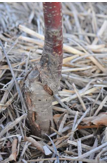
If you want a tree exactly like the parent, you must propagate that tree vegetatively. In the case of apples, this usually means grafting. Apple trees are actually quite easy to graft, even for novices. Don't be afraid to try even if you haven't grafted before. The step that needs to be done at this time of year is the choosing and cutting of scion wood or small branches that will be grafted on top of a rootstock.
See the accompanying article in this newsletter on how this is done. However, if you don’t have an existing tree to graft onto, you will need to plant a rootstock this year for grafting onto next. Fruit trees are normally grafted (or budded) onto specially selected rootstocks. These rootstocks usually reduce tree size. For example, a tree that normally would reach 25 feet tall will only reach 10 feet if it is grown on a certain rootstock. Dwarfing rootstocks also allow apples to bear fruit a year or more earlier.
A tree on its own roots normally takes 5 to 7 years before it will bear. Semi-dwarf trees bear in 4 to 5 years, and dwarf trees bear in 3 to 4 years. Unfortunately, not all dwarfing rootstocks are well adapted to Kansas. Semi-dwarf trees usually are a better choice for us. Note that rootstock reduces tree size, not fruit size. Therefore, a Golden Delicious tree that only reaches 8 feet tall due to a dwarfing rootstock, will bear the same size fruit as a Golden Delicious tree that is 25 feet tall.
Most nurseries only sell trees that are already grafted. A company that does sell rootstocks is Raintree Nursery, Morton, WA, (360) 496-6400, http://www.raintreenursery.com/Rootstocks/ Another is Cummins Nursery, 865- 233-3539, http://www.cumminsnursery.com/rootstocks.htm though there is a minimum shipping and handling fee of $20.
It is also possible to buy a tree from a local nursery and graft your clone into it. This will give you one tree that produces two different apples. One disadvantage of this method is that it is possible to prune off the special clone by mistake in later years.
This information does not include the details of grafting or budding or subsequent care. The Missouri Extension Service has an excellent publication on grafting at http://extension.missouri.edu/explorepdf/agguides/hort/g06971.pdf as well as a second publication on budding at http://extension.missouri.edu/explorepdf/agguides/hort/g06972.pdf . Be sure to practice your cuts on wood you prune off in March. After you do about 100 cuts, you will start to get the hang of it. (Ward Upham)
Vegetables:
Using a Planting Calendar
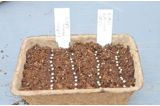
Plants should be seeded in early February. Information on how many weeks it takes to grow transplants is available in our January 6 newsletter at http://www.hfrr.ksu.edu/doc4036.ashx
Below are examples of some common vegetables grown for transplants and a recommended date for seeding. Dates are Saturdays as this is when many homeowners have the most free time. The dates are not set in stone, and a week earlier or later will not ruin the plants. Also, you may want to seed a week or two earlier if you are in southern Kansas and possibly a week later if you are in northern Kansas. Keep notes on how well the transplants did so you can tweak the
planting schedule. Your conditions may result in plants that need a bit more or a bit less time. (Ward Upham)
Crop Seeding Date Transplant Date
Cabbage, broccoli, cauliflower February 6 April 2
Lettuce (if your grow transplants) February 6 April 2
Peppers March 19 May 14
Tomatoes March 26 May 7
Flowers:
Miniature Roses
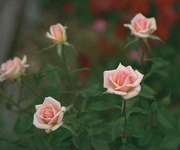
15 inches tall or less), they are surprisingly tough and can be planted outside where they will survive our Kansas winters if mulched. However, many gardeners like to grow the miniatures indoors where they can enjoy them during the drab winter months.
Miniature roses grown as houseplants have specific requirements. For long lasting flowers, air should be moist with a relative humidity of 50 to 60 percent preferred though 40 percent is adequate. Placing the pots on a tray that holds moist pebbles will help provide the humidity needed.
Like most plants, roses need a lot of light in order to flower. Though miniature roses will survive in a south window, many people will supplement available light with fluorescent lamps. Timers can be used to automatically turn the lights on and off. Providing 14 hours of light per day will be plenty for roses to grow and flower. Lights are normally spaced 3 to 4 inches above the tops of the plants.
Probably the most serious pest of these plants indoors is spider mites. These mites are very small but can devastate miniature roses. They like dry, warm conditions. Maintaining adequate relative humidity levels and washing the plants once a week in tepid water will help prevent problems. If mites do develop, try using an insecticidal soap or horticultural oil (2 percent rate) for control. The horticultural oil will probably be more effective than the soap. Be sure to spray or wash the entire plant including the underside of the leaves so that all mites are contacted.
Miniature roses can be placed outdoors during the summer to take advantage of higher light levels. Do not place the plant in full sun immediately but gradually grant more light over a period of several weeks. Pots sunk in the ground will not need to be watered as often as those exposed. Turn the pot 180 degrees every couple of weeks to break off any roots that escape the pot and move into the underlying soil.
Miniature roses are not the easiest plants to grow as houseplants but can be well worth the effort required. (Ward Upham)
Miscellaneous:
Plants Recommended for Kansas
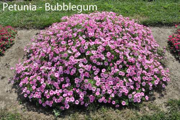
We also have images of hundreds of the following:
Varieties of iris and daylilies found in the University Gardens Collection Gardens at http://www.ksre.ksu.edu/ksugardens/p.aspx?tabid=38
Annual flowers recommended for Kansas at http://www.prairiestarflowers.com/Prairie_Star_nav.html
Perennial flowers at http://www.prairiestarflowers.com/Prairie_Bloom_nav.html (Ward
Upham)
Contributors: Ward Upham, Extension Associate
 RSS Feed
RSS Feed
